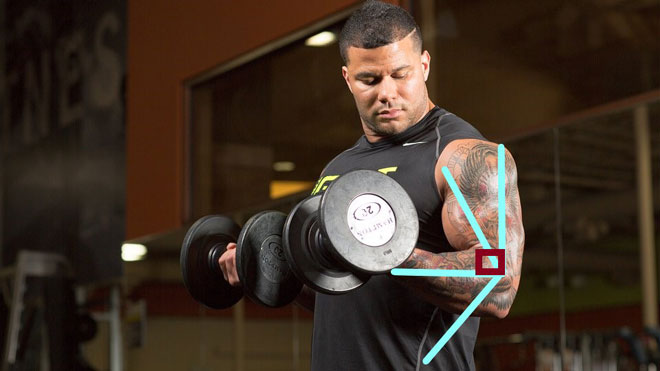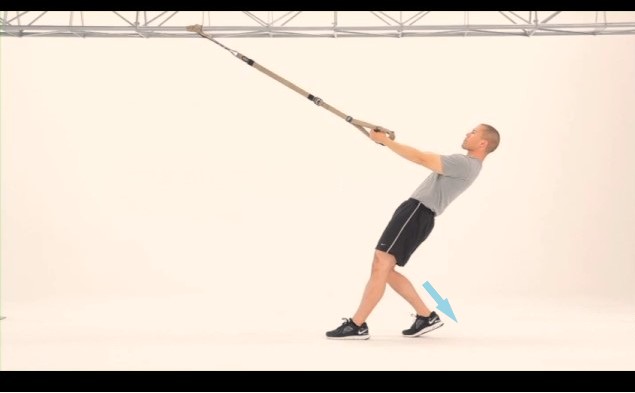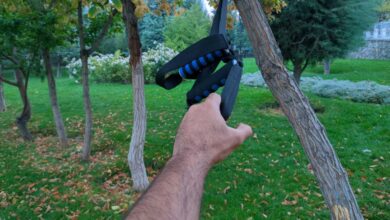Muscle generates force through different phases of contraction. Muscle is made of small fibers that are called myosin. Muscle contractions happen through shortening and loosening of these small fibers. As a result, muscle shortens or muscle lengthens. There are different types of muscle contractions and in this study, we review those that are mostly used during TRX training and learn innovative ways to utilize them for better results.
Here is our tutorial to make your homemade TRX.
Table of Contents
TRX Isometric Exercises
Isometric muscle contraction is one of the types of muscle contractions that maintains static pressure on the muscle without shortening or lengthening of the muscle fibers. During this type of exercise, joints are in a fixed state and muscle fibers are activated at a fixed angle. An example of TRX isometric exercise is in the midway of a full-range TRX push-up where you can hold in that position for an extended period of time before continuing the eccentric phase. Isometric exercises will not necessarily help you to do more repetitions during training.

Isometric contraction can be used in post-injury recovery. When different types of muscle contractions can be painful, isometric muscle contraction can help to maintain strength during recovery.
Physical therapists may also recommend isometric exercises for patients with arthritis because performing any different types of muscle contractions in full range of motion can aggravate it. So, initially applying isometric exercise can help them to improve their strength.
There have been studies on the effects of isometric exercises on people with high blood pressure and normal blood pressure that show both groups who practice isometric exercises experience lower blood pressure. Here are a few TRX isometric exercises:
- TRX Iso Hold or TRX Iso Row. TRX iso hold is a TRX isometric exercise that activate posterior muscles. Body positioning is similar to TRX back row. In TRX iso hold after contracting back muscles and pulling body upwards, hold in that position for a few seconds and then release.
- TRX Iso Squat Calf Raises. Body positioning in TRX Iso squat is similar to TRX squat, except in TRX iso squat hold in a seated position for a few seconds. For TRX iso squat calf raises, add calf rising during TRX iso squat hold.
- TRX Isometric Push-up
Isotonic Muscle Contraction
Isotonic contractions are the type of contractions that maintain a constant amount of tension on the muscle throughout the movement. Typical weight training exercises are amongst the isotonic muscle contractions examples where the amount of weight remains constant throughout the range of movement. Isotonic contractions consist of two different types of muscle contractions: concentric contractions and eccentric contractions.
Concentric Muscle Contraction
In different types of muscle contractions, concentric muscle contraction is the typical exercise that is used during weight training or other types of resistant training. It is the typical type of muscle contraction for improving strength and building muscle mass through hypertrophy sets. Considering the example of TRX bicep curl, concentric muscle contraction is the positive phase of movement during which muscle fibers are shortened and drag the forearm towards the upper arm.

Concentric muscle contraction in bodyweight training versus weight training
Practicing bodyweight training especially TRX suspension training adds particular variations to different types of muscle contractions which are exceptional features of bodyweight exercise.
During traditional weight training, the amount of weight that muscle lifts in each repetition is a fixed amount. However, throughout a full range of motion, a muscle experience different levels of pressure at different angles.
Again, we can consider bicep curl with dumbbell to illustrate this. The amount of resistance that the bicep endures at 30°, 90°, 130° angles are different. The maximum amount of pressure on the bicep is at 90° angle. The three drawings depict the eccentric phase of a bicep curl.

Therefore, in order to put maximum pressure on muscle at various angles during weight training, trainers suggest different variations of an exercise in different body positions or using weight machines. For example, doing bicep curl while sitting on a preacher curl bench.
Concentric muscle contraction in TRX training with intelligent weight
However, in bodyweight training, we benefit from ‘intelligent weight’. It means we have this exceptional opportunity to micro-adjust the amount of pressure by increasing or decreasing a portion of our body weight on the targeted muscle.
We consider the example of bicep curl with TRX to illustrate this type of concentric muscle contraction. While doing bicep curl with a TRX suspension trainer, we lean backward to put a portion of body weight on the bicep. At the same time, we put one leg back. This back leg supports the rest of body weight and also allows us to micro-adjust the amount of pressure that we want to put on the bicep muscle.
This way during concentric muscle contraction we can increase or decrease the pressure on the bicep. Whenever we need more weight, we reduce the support of the back leg; therefore, more weight is on the bicep. Similarly, when the amount of weight is more than muscle power, with increasing the support of the back leg we reduce the amount of weight on the bicep.
We do not exaggerate if we claim that the human body is the most intelligent weight machine. Notice that during a full range of movement in different types of muscle contractions, muscle power can vary. By using this feature of ‘intelligent weight’ in bodyweight training, we have advantages of different pieces of gym equipment in our TRX training.
“Intelligent weight” is a concept pioneered by Training Bodyweight. It involves implementation of different techniques to make micro-adjustments in the amount of resistance on the target muscle.

Eccentric Muscle Contraction
Eccentric muscle contraction is the reverse phase of concentric muscle contraction. In these types of muscle contractions, muscle fibers are stretched. Considering the example of bicep curl, eccentric muscle contraction is the negative phase from maximum contraction of the bicep towards the straight position of the arm.
Two different usages of eccentric muscle contractions in strength training
- Typically, in different types of muscle contractions, eccentric muscle contractions in bicep curl are when the arm returns to its original straight position. The amount of force produced by the muscle during eccentric contractions is less than the weight it carries. Hence, in these types of muscle contraction, concentric contractions are the main phase that tolerates the most resistance.
- However, another type of eccentric muscle contraction is when the focus of exercise is on the negative phase. In this state the concentric contraction is faster and can accompany some help from a training partner, but the eccentric contraction is the main phase where you lower the weight slowly and try to activate muscle fibers to their full potential.
Eccentric muscle contraction in TRX suspension training
The same principles apply to TRX suspension training. There is an eccentric phase of muscle movement when we allow our body weight to open the arm slowly and in a controlled state after concentric contraction.
There is also an eccentric muscle contraction that the focus of our exercise is on the negative phase. Taking the example of bicep curl, we start from the state of fully bent elbow and we slowly drop our body weight backward while one back leg supports the movement. At the same time bicep tries to resist this movement but since the body weight is more than bicep strength, it is slowly stretched until the arm is in the straight position.
Note that during this type of eccentric muscle contraction, we shall not help the opening phase of the arm with our supporting back leg and make the movement easier for the bicep. Rather, the amount of resistance should be big enough to activate muscle fibers to their full potential.
The natural tendency of body in eccentric exercise
In all different types of muscle contractions, there should be a constant resistance on muscles throughout the range of movement. This is a natural tendency of the body that we support our body weight when we lose balance. Nevertheless, in eccentric contraction with TRX, we intentionally lose our balance to produce resistance.
In the beginning, we may involuntarily interfere in the movement with the support of the back leg, but gradually we will learn to take it under control and produce a consistent resistance throughout the movement. The muscle should generate sufficient force to make the eccentric phase a slow and controlled movement.
Similar to concentric muscle contraction, in all different types of muscle contractions, we can benefit from the ‘intelligent weight’ technique. In eccentric muscle contraction, we control the amount of pressure that the biceps have to endure during each repetition with the support of the back leg.
Rehabilitation with eccentric contractions
Amongst different types of muscle contractions, eccentric contractions can also be used for physical therapy. The lowering phase of muscle acts puts less strain on joints and stabilizing ligaments of knees, in comparison to the concentric act. There are also other types of medical conditions in which eccentric contraction is used as a part of the treatment process.
For more information study, Eccentric Calisthenics Training for Strength and Fitness.
TRX Plyometric Workout
Plyometric exercises, also known as jump training or explosive training, are a type of exercise that involves high-intensity, explosive movements to build power, speed, and agility. These exercises aim to improve neuromuscular coordination, increase muscular strength, and enhance overall athletic performance.
TRX suspension trainers add an extra challenge to traditional plyometric exercises by adding instability to the movements. This requires additional muscle activation and control to perform the exercises correctly.
Some examples of TRX plyometric exercises include:
- TRX Jump Lunges: Begin in a lunge position with one foot forward and one foot back, holding onto the TRX straps. Quickly jump up and switch the position of your feet in mid-air before landing softly and repeating on the other side.
- TRX Plyo Push-Ups: Start in a push-up position with your hands on the handles of the TRX straps. Perform a push-up, then explosively push off the ground and let go of the handles, landing on your feet before quickly jumping back into the starting position and repeating.
- TRX Single Leg Plyo Jumps: Stand facing the TRX straps with one foot in the foot cradle and the other foot flat on the floor. Lower into a lunge position on the ground while keeping your weight in your front heel. Explode up off the ground and switch feet in mid-air before landing softly and repeating on the other side.
It’s important to note that plyometric exercises require proper technique and form to prevent injury. Beginners should start with low-impact exercises and gradually increase intensity over time.
Learn how to add TRX plyometrics into your routine in incorporating plyometrics into strength training program.




